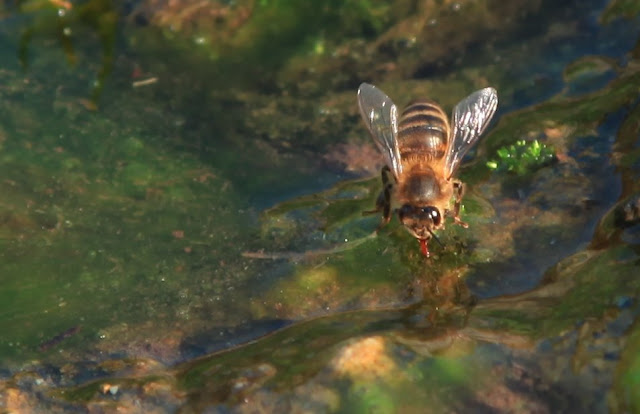We have recently expanded the "Beauty for Ashes" website to include the crafts, prints and jewellery that we make. These have previously only been available in the craft shop on Enlli. Do take a look and if you like it, let your friends know!
Here's the link: http://www.beautyforashes.co.uk
Saturday, March 24, 2012
Sunday, March 4, 2012
Busy bees
We have recently enjoyed what has felt like the first taste of Spring. Yesterday I spent a while watching and photographing the bees as they excitedly made the most of the calm and warm day . At the hive entrances , large amounts of gorse pollen was being brought in , as well as the odd yellow-dusted worker returning from the willow blossom.
The Spring build up is quite slow on Bardsey , probably because of the exposed nature of the island and also because their nectar sources don’t really begin to appear in any quantity until late May . The first of these is the wonderful salt-tolerant Thrift (‘Sea-Pink’) which carpets much of the coastal heath and ancient earthen banks (‘Clodddiau’) .Nestled among their taller neighbours are the vivid blue flowers of Squill , which the bees also like to visit. Literature suggests that Thrift can produce a honey surplus in favourable conditions but I have yet to observe this happen . The usual time for the main honey flow has been during late June and into July , corresponding to the flowering of the abundant white clover. Mixed in , for extra flavour , the bees add nectar from Brambles , Bird’s-Foot Trefoil and Bell-Heather.
I have been pleasantly surprised at the consistent harvest of honey that we have had over the last eight years , usually a modest 30-40 lbs per hive. I sacrificed some of the honey yield last year for the sake of increasing the number of colonies. I now have six hives. I’m hoping this will help meet the demand for ‘Bardsey Honey’ at our cafe/craft shop which regularly runs out part way through the summer.
Some of the advantages of having such a unique and isolated apiary include being largely beyond sources of disease and the re-infestations that can affect mainland bees. I have not seen a Varroa mite in my hives for at least three years now ,much to my relief. However , one of the down-sides of isolation is the weakening affect of in-breeding. While I still had my bees in Conwy I would regularly bring nucleii over to enrich the gene-pool. More recently though , without my Conwy bees and with the difficulty of transporting nucs , I have begun to use bought-in queens. I will be watching with interest this season to see how they perform compared with their in-bred predecessors.
The sheep and cow proof apiary.
Bees bringing pollen loads back from Gorse (orange) and Willow (yellow).
It's useful to have a landing pad when you're arriving home tired and heavily laden !
Glass crown-boards enable me to check on the bees without disturbing them too much.
" Buzz off....this is my flower !"
Working on the Willow...
Working on the Gorse....
Working on the Hebe..
Subscribe to:
Posts (Atom)










